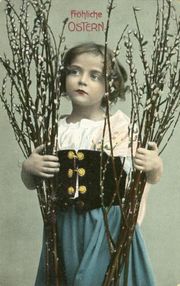 Easter postcard from 1901
Easter postcard from 1901
|
From Wikipedia the free encyclopedia, by MultiMedia |
 Easter postcard from 1901
Easter postcard from 1901

Easter postcards are a form of postcard that people send to each other at Easter. They have now mostly changed to cards rather than postcards, however their purpose remains the same.
The tradition to send Easter postcards to relatives and friends developed in the end of the 19th century. During the year 1898 were only a few cards sent but the amount of sent cards raised in the following years worldwide. Soon it was courteous to send Easter postcards and to not get a card from this godchild was nearly an insult.
In the beginnings monochrome as well as colored cards were printed. Most of the time in the center of the cards was an oversized egg. In the first years of the Easter postcards often a part of the front side was empty. This was the space for the greetings of the sender because the post-order only allowed the address and the stamp on the back side. Because of that the artistically precious illustrations were deformed. In 1905 the post in Austria and Germany separated the back side of the cards in two halves. The right half served as before for the address and the stamp and the other one was the new space for the message. 1906 this was officially allowed by the world-post-congress in Rome.
In the years around 1910 on the cards were mainly monochrome pictures which were sometimes colored with children in the context with lambs, poults and eggs. Young girls were a symbol for luck and hope. The Easter bunny which was a personified symbol of fruitfulness was often portrayed with eggs. German publishers were leading in the production of Easter postcards before the first world war.
During the time of the first world war the children were replaced through soldiers and a military appearance of the Easter bunny was common. After the first world war not photos were the foundation for Easter postcards anymore but drawn colorful Easter motives. At this time a very popular motive was Jesus in the open countryside surrounded by sheeps. But also cards with flowers were sent very often. In the time of prosperity during 1898 and 1918 the basis of the cards was chromolithography. There exist very impressive cards with silver, gold and relief-stamping.
A big reduction of sent Easter postcards occurred through the second world war. After it the amount of sent cards raised slowly but in the last ten years it fell rapidly because of the competition with telephony and e-mail.
About Easter, made by MultiMedia | Free content and software
This guide is licensed under the GNU Free Documentation License. It uses material from the Wikipedia.